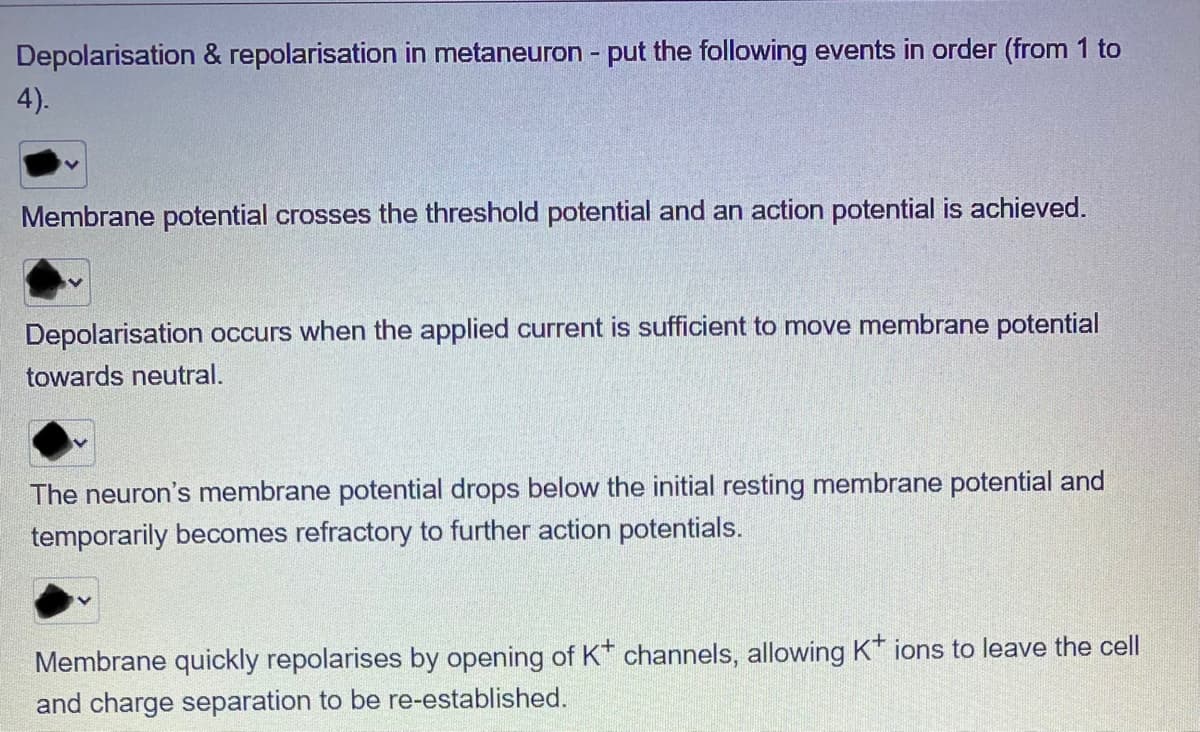Depolarisation & repolarisation in metaneuron - put the following events in order (from 1 to 4). Membrane potential crosses the threshold potential and an action potential is achieved. Depolarisation occurs when the applied current is sufficient to move membrane potential towards neutral. The neuron's membrane potential drops below the initial resting membrane potential and temporarily becomes refractory to further action potentials. Membrane quickly repolarises by opening of K* channels, allowing K* ions to leave the cell and charge separation to be re-established.
Depolarisation & repolarisation in metaneuron - put the following events in order (from 1 to 4). Membrane potential crosses the threshold potential and an action potential is achieved. Depolarisation occurs when the applied current is sufficient to move membrane potential towards neutral. The neuron's membrane potential drops below the initial resting membrane potential and temporarily becomes refractory to further action potentials. Membrane quickly repolarises by opening of K* channels, allowing K* ions to leave the cell and charge separation to be re-established.
Anatomy & Physiology
1st Edition
ISBN:9781938168130
Author:Kelly A. Young, James A. Wise, Peter DeSaix, Dean H. Kruse, Brandon Poe, Eddie Johnson, Jody E. Johnson, Oksana Korol, J. Gordon Betts, Mark Womble
Publisher:Kelly A. Young, James A. Wise, Peter DeSaix, Dean H. Kruse, Brandon Poe, Eddie Johnson, Jody E. Johnson, Oksana Korol, J. Gordon Betts, Mark Womble
Chapter12: The Nervous System And Nervous Tissue
Section: Chapter Questions
Problem 7ILQ: Watch this video (http://openstaxcollege.org/l/summation) to learn about summation. The process of...
Related questions
Question

Transcribed Image Text:Depolarisation & repolarisation in metaneuron - put the following events in order (from 1 to
4).
Membrane potential crosses the threshold potential and an action potential is achieved.
Depolarisation occurs when the applied current is sufficient to move membrane potential
towards neutral.
The neuron's membrane potential drops below the initial resting membrane potential and
temporarily becomes refractory to further action potentials.
Membrane quickly repolarises by opening of Kt channels, allowing K* ions to leave the cell
and charge separation to be re-established.
Expert Solution
This question has been solved!
Explore an expertly crafted, step-by-step solution for a thorough understanding of key concepts.
Step by step
Solved in 2 steps

Knowledge Booster
Learn more about
Need a deep-dive on the concept behind this application? Look no further. Learn more about this topic, biology and related others by exploring similar questions and additional content below.Recommended textbooks for you

Anatomy & Physiology
Biology
ISBN:
9781938168130
Author:
Kelly A. Young, James A. Wise, Peter DeSaix, Dean H. Kruse, Brandon Poe, Eddie Johnson, Jody E. Johnson, Oksana Korol, J. Gordon Betts, Mark Womble
Publisher:
OpenStax College

Biochemistry
Biochemistry
ISBN:
9781305577206
Author:
Reginald H. Garrett, Charles M. Grisham
Publisher:
Cengage Learning

Biology 2e
Biology
ISBN:
9781947172517
Author:
Matthew Douglas, Jung Choi, Mary Ann Clark
Publisher:
OpenStax

Anatomy & Physiology
Biology
ISBN:
9781938168130
Author:
Kelly A. Young, James A. Wise, Peter DeSaix, Dean H. Kruse, Brandon Poe, Eddie Johnson, Jody E. Johnson, Oksana Korol, J. Gordon Betts, Mark Womble
Publisher:
OpenStax College

Biochemistry
Biochemistry
ISBN:
9781305577206
Author:
Reginald H. Garrett, Charles M. Grisham
Publisher:
Cengage Learning

Biology 2e
Biology
ISBN:
9781947172517
Author:
Matthew Douglas, Jung Choi, Mary Ann Clark
Publisher:
OpenStax